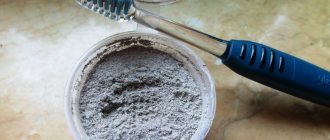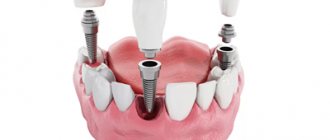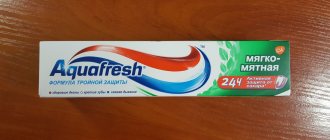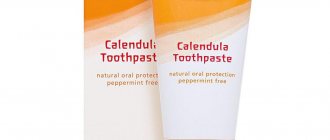Regular and complete oral hygiene is the key to healthy teeth, gums and other structures in this area. Of course, hygiene in this case is based on brushing your teeth, the correct implementation of which today is impossible without the use of toothpaste.
However, the market for oral hygiene products today is crowded. The shelves of stores and pharmacies are full of toothpastes, and the number of their manufacturers is amazing.
In such realities, the question arises - “how to find the best toothpaste that suits me?” To get the answer, you need to have a clear understanding of the classification, as well as the principles for choosing this product for oral hygiene.
What types of toothpastes are there - classification
The ability to choose is an important skill, on which the condition of the structures and health of the oral cavity subsequently depends. An incorrectly selected oral hygiene product can provoke the development of a number of serious problems such as increased tooth sensitivity and bleeding gums.
You may have to visit a dentist before purchasing. The doctor will examine the oral cavity, point out nuances that require adjustments, protect you from making the wrong choice, and tell you what toothpaste you need.
When purchasing, it is important to remember the classification, within which toothpaste is divided into the following types:
- Children's - these do not contain aggressive components, they are known for their gentle effect on the structures of the oral cavity. It is important to pay attention to the age limit indicated on the packaging. When buying children's toothpaste, also make sure that it contains dicalcium phosphate and silicon dioxide, and that the CDV value does not exceed 50 units. It is also important to remember that it is not advisable for an adult to brush their teeth with children’s toothpaste; it is intended primarily for young children and adolescents.
- Whitening - the peculiarity is that this paste contains microparticles of abrasive materials used in dentistry. Thanks to this composition, the whitening helps get rid of stubborn plaque (but does not get rid of tartar). At the same time, tooth whitening paste is not recommended for people with thin enamel or hypersensitive teeth, the problems will worsen.
- Anti-caries - the peculiarities of the chemical composition of this type of hygiene products allow them to penetrate into hard-to-reach places. The components that are included in anti-carious toothpaste help strengthen the enamel layer and reduce tooth sensitivity. This type of toothpaste is used in the initial stages of carious formations; it strengthens the enamel, preventing the spread of caries.
- If there is bleeding, sensitive gums need care. Pastes of this type contain special components (often of natural origin) that have anti-inflammatory, hemostatic and antibacterial effects, and also accelerate tissue regeneration. When using a correctly selected paste of this type, after 20-30 days, inflammation of the gums is eliminated, they stop bleeding, and other problems can be dealt with.
- Hygienic (preventive) - if the previous options had features, then hygienic toothpaste can be called standard. This choice should be made by people with a completely healthy oral cavity, in the absence of complaints of increased tooth sensitivity or thinning of the enamel layer. They have a slight whitening effect, have an antibacterial effect, strengthen enamel and maintain gum health, preventing caries and periodontal disease.
Cervical caries: causes
Why does this type of caries occur? First of all, this process is influenced by the proliferation of microorganisms in the oral cavity. The enamel on the root part of the tooth is much thinner; it is more difficult to thoroughly clean tartar and plaque there, so this area of the tooth is perhaps the most favorable for the growth of bacteria.
Other causes of cervical caries include:
- detachment of the gums, in the pocket of which food accumulates;
- periodontitis;
- gingivitis;
- bad habits (primarily smoking);
- Regular consumption of carbohydrates, especially if you do not brush your teeth afterwards;
- frequent consumption of acidic foods;
- pregnancy;
- taking certain medications;
- certain diseases (thyroid, diabetes, etc.).
Therefore, it is very important to monitor the condition of your teeth and visit the dental office regularly to diagnose dental problems at an early stage.
Most often, this type of caries develops in people after thirty years of age, because by this age the tooth enamel becomes thinner and can no longer protect the tooth from bacteria as effectively as before. And in elderly patients after sixty years of age, it is the main cause of tooth loss.
Those who have cervical caries on several teeth at once should also be wary. It is quite possible that this indicates a metabolic disorder. In this case, you need not only to visit the dentist, but also to undergo examination by an endocrinologist.
Disadvantages of toothpastes
It was invented to take care of the condition of the structures of the oral cavity and maintain human health. If we exclude second-rate products from unknown manufacturers and talk about good brands, the negative impact of using the paste for a healthy person is minimal (provided it is chosen correctly).
But toothpaste has relative disadvantages:
- Impact on the gastrointestinal tract - some substances contained in toothpaste, penetrating into the gastrointestinal tract, can contribute to the development of dysbiosis or episodic outbreaks of diarrhea. But for brushing your teeth to lead to such results, a person must have serious problems with the condition of the gastrointestinal tract or he must brush his teeth more than 2-3 times a day.
- Some aggressive components penetrate the systemic bloodstream, being absorbed through soft tissues during tooth brushing. However, manufacturers have tried to minimize this risk by adding menthol to the paste, which cools the mucous membrane, reducing the intensity of absorption.
- Restriction in use - refers to those toothpastes that are intended for treatment and have, for example, a whitening effect. This can be used for periods of 2-4 weeks, taking breaks; constant brushing of teeth with such means can be harmful.
- Addictive effect - dentists are convinced that if you brush your teeth with the same toothpaste for 2-3 years or more, its effect decreases. To prevent this, you should choose 2-3 pastes for yourself and change them periodically.
- Colors and flavors – today you can often find red or orange strawberry or peach toothpaste on store shelves (colors and flavors may vary). Even if natural food colorings and flavorings are used, they can cause an allergic reaction. Therefore, it is safer to give preference to classic pastes. The classic option is white.
Cervical caries: what to do and when to start treatment
Like other types of caries, cervical caries also has several stages of development. It starts with a small demineralized spot. It may be either white or have slight pigmentation. It is quite difficult to notice the onset of the disease on your own at such an early stage, because there is no pain yet, only tarnishing of the enamel is noted, which takes on a matte tint. Only a qualified dentist can determine the early stage of cervical caries.
As a rule, a person begins to realize that something is wrong with his teeth only at the stage of caries, when the teeth begin to react to changes in temperature, sweet or salty foods. Having discovered one of these symptoms of cervical caries, the patient consults a doctor and begins treatment.
If you continue to ignore the unpleasant symptoms, then caries affects the nerve endings, and the person begins to feel severe pain even from the smallest irritants, for example, from cold air getting into the tooth. The disease begins to progress rapidly and can lead to gumboil, abscess and tooth decay. Patients may also experience:
- inflammation of gum and tooth tissues;
- gingivitis;
- pulpitis;
- periodontitis.
And holes may appear on the teeth, which are visible visually.
Cervical caries: treatment at the white spot stage
If this type of caries was detected at a very early stage, when the stain had just appeared on the tooth enamel, then it should be treated by saturating the tooth enamel with calcium. To do this, you can use special remineralizing preparations that contain fluoride and calcium. These can be either special toothpastes containing these microelements or professional dental preparations. The choice in favor of a specific remedy must be made by the dentist after assessing the condition of the patient’s teeth and how damaged his tooth enamel is.
In any case, before starting treatment, you need to remove plaque and tartar from the surface of the tooth. To do this, the dentist can use a special abrasive paste and polishing tools. After this, you can begin to remineralize the damaged tooth.
Cervical caries: how to treat if the process is started
If cervical caries has progressed from the stain stage to the destruction of tooth enamel, then remineralizing drugs alone will not be enough to treat it. In this case, cervical caries is treated in the same way as regular caries.
- The dentist cleans the tooth from plaque and tartar.
- Selects the color of the filling individually, taking into account the shade of tooth enamel.
- Prepares the carious area using a spherical bur.
- Prepares the tooth for filling.
- Fills a carious defect on the neck of a tooth.
- Grinds and polishes the resulting filling to give the tooth the correct physiological shape.
A filling for cervical caries can be installed if the dental canals are slightly damaged. If caries has already penetrated into the pulp, the dentist cleans the canals, treats them, fills the tooth and installs a dental crown.
And in the most advanced stage, the tooth will have to be removed altogether and an implant installed in its place. It is imperative to consider the consequences of wisdom tooth removal.
It is advisable, of course, not to allow this to happen and to contact the dentist as early as possible. After all, a carious cavity may look small on the outside, but be quite significant on the inside; it can damage the base of the tooth and spread to neighboring ones.
How to choose the right toothpaste
When choosing good toothpastes, it is important to find a product that best suits you according to other criteria. To do this, it is necessary to take into account a number of nuances:
- Purpose – for what purpose are you buying the paste, what task should it perform? Perhaps you have problems with the condition of your oral cavity that require correction.
- Composition – for a particular person, the best paste is made by the components it contains. By paying attention to the composition, you can identify the key components for yourself that must be present or absent in the required paste.
To make it easier for you to choose the best whitening toothpastes for yourself, let’s look at the mentioned nuances in more detail.
Is professional teeth cleaning necessary?
Some dentists recommend polishing and grinding your teeth, or professional cleaning, twice a year. However, this procedure has a number of contraindications: allergic reactions to the medications used, enamel sensitivity, bleeding gums.
In 2005, eight studies[] were conducted on the effects of professional dental cleanings on dental health. None of them even confirmed the safety of this procedure, let alone the need to do it regularly.
Criteria for prescribing toothpaste
- Inflamed or swollen gums, the presence of bleeding and discomfort are a clear sign that preference should be given to a therapeutic effect. Ideally, you should take a closer look at dental products that contain chamomile or oak bark extract.
- If the shade of the tooth enamel layer changes towards brown or yellow due to bad habits or addiction to drinking coffee, it is better to choose a toothpaste with a whitening effect; it will help clean and brighten the enamel.
- If the enamel is thinned or the teeth are highly sensitive to cold and hot, give preference to gentle pastes, usually these are marked o.
- If you notice even small patches of caries on your teeth, but you can’t go to the dentist now, purchase an anti-caries paste that will slow down the progression of the problem.
Prevention of cervical caries
It is important to know not only the symptoms and treatment features of cervical caries, but also measures to prevent this disease.
To prevent the development of this type of caries, you should:
- Carefully monitor the condition of your teeth and regularly visit the dental clinic.
- Take care of your oral hygiene, use high-quality products, for example, Asepta toothpastes containing the enzyme papain. It effectively breaks down plaque, making your teeth healthy and your breath fresh.
- Massage the gums.
- Take care of your diet, paying attention to foods high in calcium, fresh vegetables and fruits.
- Try to eat hard foods as often as possible, such as apples and carrots, which require effort to chew.
- Give up bad habits, in particular smoking.
- Try to avoid regularly drinking very cold or extremely hot drinks, especially coffee.
- Forget about cracking nuts with your teeth, especially if you want to avoid cervical caries of the front teeth; Peel the seeds exclusively with your fingers; Do not open bottles with your teeth.
- After each meal, try to brush your teeth or at least rinse your mouth, get rid of food debris using dental floss, or chew sugar-free gum for a couple of minutes.
- Avoid snacking on chips, sweets and buns, which promote the growth of bacteria. For snacks, you may prefer an apple or cottage cheese.
- On the recommendation of a doctor, use pastes with a high content of calcium and fluoride.
- Get rid of pigment plaque and deposits on tooth enamel in a timely manner.
- Take vitamins regularly and monitor your health, in particular, blood sugar levels and thyroid condition.
Prevention of cervical caries is important not only for those who have never had this disease, but also for those who have undergone treatment to prevent it from spreading to other teeth.
Toothpaste composition criteria
- Containing fluoride is a good option, providing a pronounced antibacterial effect and preventing the occurrence of carious lesions. But fluoride negatively affects the condition of bone tissue, so the use of such a paste should be alternated with products that do not contain fluoride.
- Soda-containing sodium carbonate particles in dental products serve as an abrasive, which over time damages the enamel and mucous membranes of the mouth. If you need to whiten your teeth and clean them of plaque, this paste can be used, but it also needs to be alternated.
- Plant components – it’s good if the paste contains extracts of propolis, oak bark, chamomile, and pine needles. These components do not cause harm and constantly maintain the condition of soft tissues.
- The concentration of parabens is not higher than 2% - parabens are preservatives that extend the shelf life of dental products, but when their content exceeds 2%, a health hazard appears.
How dangerous is the disease?
If cervical caries is not treated, the following complications may quickly appear:
- Pulpitis is an inflammation of the soft tissue (pulp) located in the dental cavity. The infection enters the pulp when hard tissue is destroyed. Symptoms: severe excruciating pain in the tooth, appearing regardless of food intake, including at night.
- Periodontitis is an inflammation of the ligament that holds the tooth root in the cell (periodontal). The infection enters the periodontium through the root canals. The pain becomes unbearable, often pulsating, and intensifies with chewing (mechanical irritation). Fever and general malaise appear.
- An abscess at the root apex is a capsule filled with pus. Severe pain, severe fever, chills.
- Osteomyelitis is an inflammation of the jaw bone. The condition is serious and urgent hospitalization is required.
- Periodontitis – inflammation spreads to the periodontal tissues, the gums become inflamed and bleed. Pockets form between the gum and neck, into which food becomes trapped, maintaining the infection. It is painful. Treatment takes a long time and is not always successful; much depends on the patient’s immunity.
- Lateral spread of infection to the necks of adjacent teeth, development of multiple caries.
- Circular lesion of the neck with crown fracture.
If you suspect the presence of a carious process under the gum, you should immediately contact your dentist: complications with this form of the disease develop very quickly!
Additional selection criteria
- Expiration dates are a less serious, but important nuance. Always check the manufacturing date and expiration date; you may not be poisoned by expired toothpaste, but its effectiveness will be reduced.
- RDA value - this value indicates the amount of abrasive materials in the paste. The higher this indicator, the more thoroughly it cleans the tooth surface, but also damages the enamel layer. If you are not buying a special whitening paste, make sure that this indicator does not exceed 100 for an adult toothpaste and 50 for a child’s toothpaste.
Comparative analysis of toothpastes
To decide which toothpaste is better to buy in a pharmacy or store, consider the rating of reputable brands that you can choose without fear:
- Aquafresh is a standard option in an affordable price category; you will find it on the shelves of any supermarket. It has no pronounced shortcomings, but also cannot boast of variability.
- Lacalut is another affordable and widespread option; it is preferred when it is necessary to whiten enamel, but you should use them continuously for no longer than 4 weeks.
- Parodontax is a good combined option containing components against bleeding gums, as well as fluoride and soda particles, the price category is average. It is not recommended to use this for a long time without breaks.
- Sensodyne - this representative of the rating is intended for use for medicinal purposes for inflammation of the gums. The effect of use occurs already in the first week, but you cannot use it for a long time.
- ROCS is a popular, but not budget line, in which there is a separate distinction between children's and adult toothpastes. The line includes different types, each of which is designed to solve specific problems.
- Splat is a competitor to the previous one, as they are presented in similar price categories, and also have different product options aimed at eliminating specific problems. In the Splat series you will also find children's toothpaste for different ages.
- Forest balm is an inexpensive but bright representative; these toothpastes contain plant extracts and extracts. A good option for long-term use if you want to improve the condition of your gums.
Author: Zhukov M.A.
Diagnostics
The dentist begins by examining the patient's mouth using a dental mirror. If there is a defect in the crown, it is examined using a probe. After this, the doctor prescribes:
- X-ray diagnostics; if cervical caries of only one tooth has been detected, targeted radiovisiography is prescribed to determine its depth and volume; if a general X-ray of the jaw is necessary, an orthopantomogram is prescribed;
- electroodontodiagnostics (EDD) – determination of pulp viability and pain sensitivity of the affected tooth;
- laser fluorescence – illumination of pathological foci using a laser device;
- painting the stain with water-soluble paints (methylene blue or magenta); in places where the enamel is damaged, it becomes permeable to paint and the pathological focus acquires clear contours;
- X-raying the crown using a special lamp to detect any hidden cavities.










